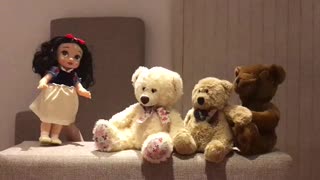Goldilocks and the Jivin’ Bears c. 1944 : The Censored Eleven
The Censored Eleven is a group of Looney Tunes and Merrie Melodies cartoons originally produced and released by Warner Bros. that were withheld from syndication in the United States by United Artists (UA) in 1968. UA owned the distribution rights to the Associated Artists Productions library at that time and decided to pull these eleven cartoons from broadcast because the use of ethnic stereotypes in the cartoons, specifically African stereotypes, was deemed too offensive for contemporary audiences. The ban has been continued by UA and the successive owners of the pre-August 1948 Looney Tunes/Merrie Melodies. These shorts have not been officially broadcast on television since 1968 and have only been exhibited once theatrically by Warner Bros. in Spring 2010 (see below for more details) since their withdrawal. They have turned up, however, on low-cost VHS and DVD collections over the last thirty years.
https://en.wikipedia.org/wiki/Censored_Eleven
Goldilocks and the Jivin’ Bears, a “Merrie Melodies’ episode from 1944, has several distinctions. It is the most recent of the Censored Eleven cartoons from Warner Brothers. The film is also the only film among the eleven to have been produced by Eddie Selzer, who replaced his predecessor Leon Schlesinger earlier that year. The cartoon is also unique in the list for having a wide array of creatures with African American caricature; three humans (Red Riding Hood, Goldilocks, and a messenger), three bears, and a wolf all have big lips and speak in dialect. In other episodes the caricature is either only on people, as in Clean Pastures, or on animals, as in Tin Pan Alley Cats. The mixture in Goldilocks and the Jivin’ Bears is reminiscent of Metro-Goldwyn-Mayer’s cartoons pairing an African American boy named Bosko with big-lipped caricatures of jazz musicians as frogs.
By the time of Goldilocks, Warner Brothers had already parodied the old story in Bugs Bunny and the Three Bears, which features a family of bears. Interestingly, the African American bears in Goldilocks are not a family but three male bears of different sizes living in the same house. They leave the house, and a wolf looking for Red sees Goldilocks enter the bears’ house. Just as he catches her in the house, the bears return and mistake the wolf’s entanglement with Goldilocks for jitterbugging. The bears proceed to play jazz, and Goldilocks is compelled to dance with the wolf until he is exhausted. He goes to Red’s grandmother’s house to rest, but the bears find him and resume playing jazz. Red and her grandmother insist of dancing with the wolf–much to the wolf’s frustration.
The cartoon received positive reviews when released late in 1944. It escaped the criticism of African American newspapers and civil rights groups at the time, perhaps because the animals dominate screen time in Goldilocks; other films like Angel Puss and Sunday Go to Meetin’ Time were targeted for their African American human leads. Goldilocks performed well enough to warrant a “Blue Ribbon” reissue in 1951, and it still avoided controversy at that point. But the reissue was at the tail-end of the era of animated African American caricature; within a few months, the maid of MGM’s “Tom and Jerry” series made her final appearance in Push-Button Kitty.
Even with the original release in 1944, the African American jazz cartoon was on its last legs; Walter Lantz’s “Swing Symphonies” ended the following year. Not only had ethnic criticism begun, but jazz itself had expanded beyond African American stars. Jazz in the 1940s had big-name European American entertainers like Glenn Miller and Benny Goodman. Studios still made jazz cartoons for years afterward, and in 1957 Friz Freleng, who directed Goldilocks, directed a cartoon with a rock-and-roll score–Three Little Bops. The post-1944 cartoons, however, traded African Americans for European Americans and animals without ethnic features.
Why was Goldilocks placed in the Censored Eleven in 1968? The big lips of the bears, the wolf, and the messenger provided visual ethnic stereotyping that animators largely avoided by 1968. The tall bear and the messenger have the sleepy eyes and big lips that resemble the demeanor of lazy characters played by actor Stepin Fetchit, whose prime had long passed by 1944 and certainly by 1968. Also, multiple characters speak in ethnic dialect, and even a letter from Red’s grandmother has the written malapropism “rivetater.” With the placement of Goldilocks on the censored list, the wolf’s dancing finally stopped.
https://cartoonresearch.com/index.php/the-censored-11-goldilocks-and-the-jivin-bears-1944/
-
 2:11
2:11
Ferik203
4 years agoGoldilocks and the three bears
134 -
 0:19
0:19
locheelad
3 years agoBackyard bears
1.86K -
 2:16
2:16
Gorlag
3 years ago $0.04 earnedCensored content
336 -
 0:27
0:27
ScottysThoughties
3 years agoSeven Eleven
1081 -
 2:02
2:02
For The Love Of God Records
3 years agoProject Eleven Campaign
64 -
 2:06
2:06
dawnhalo
3 years agoBearizona Bears
617 -
 0:30
0:30
AhmedGubran
3 years ago $0.04 earnedPolar bears playing
2764 -
 1:20:16
1:20:16
Bright Insight
1 day agoFriday Night LIVESTREAM
96.5K59 -
 20:54
20:54
Stephen Gardner
1 day ago🔴JUST IN: Fox News Jesse Waters SHARES BAD NEWS from Trump’s Lawyer!
97.5K222 -
 7:46:34
7:46:34
Vigilant News Network
1 day agoBad News Strikes Diddy in Stunning New Development | The Daily Dose
105K75